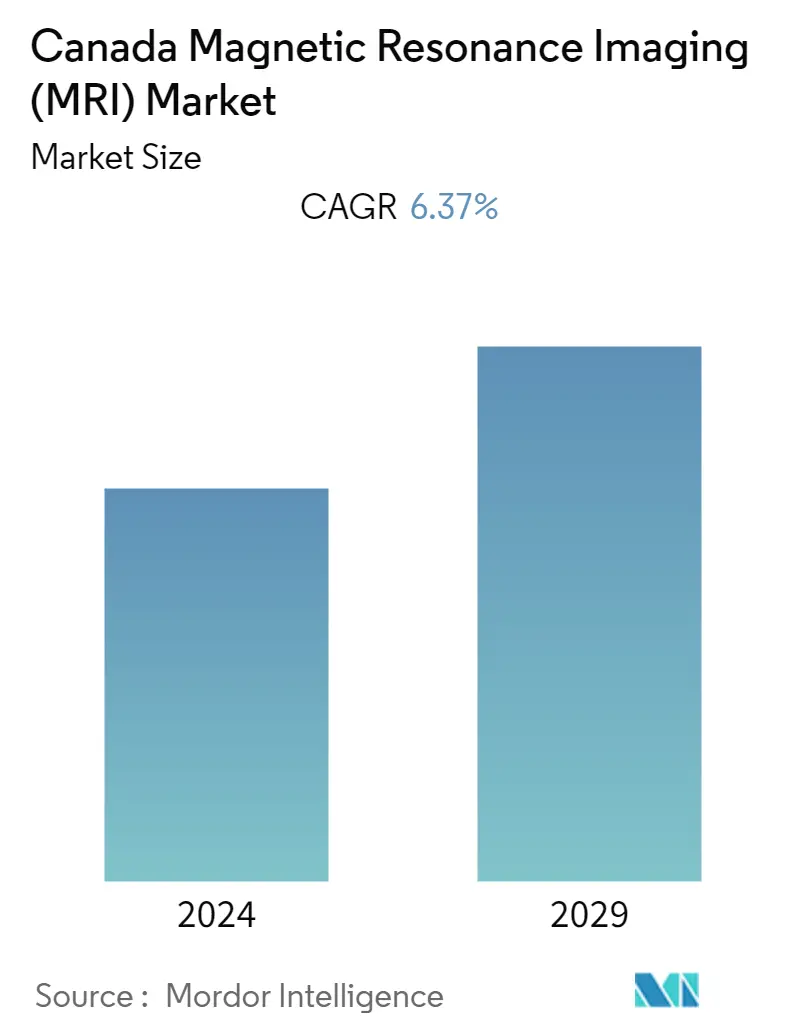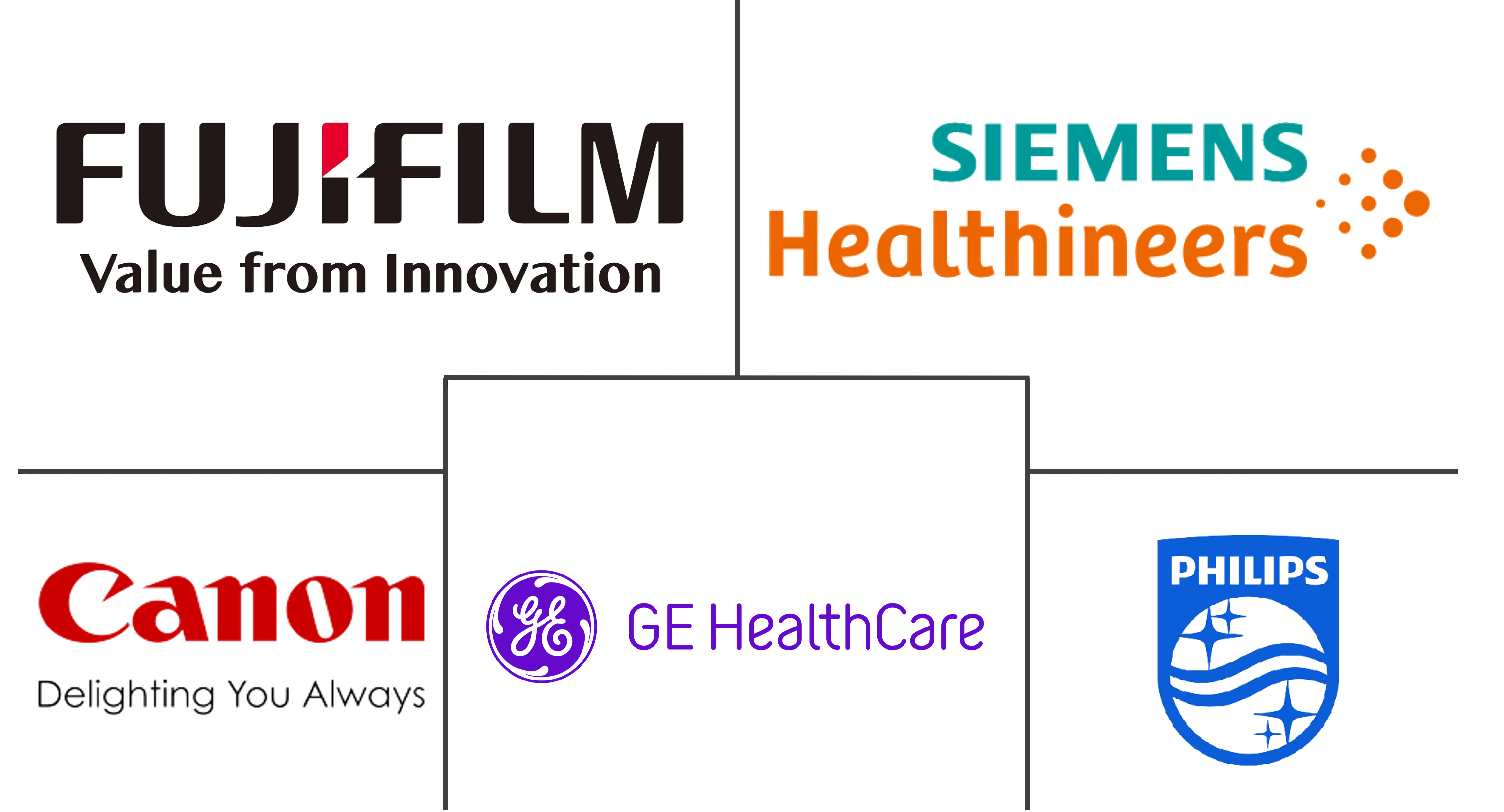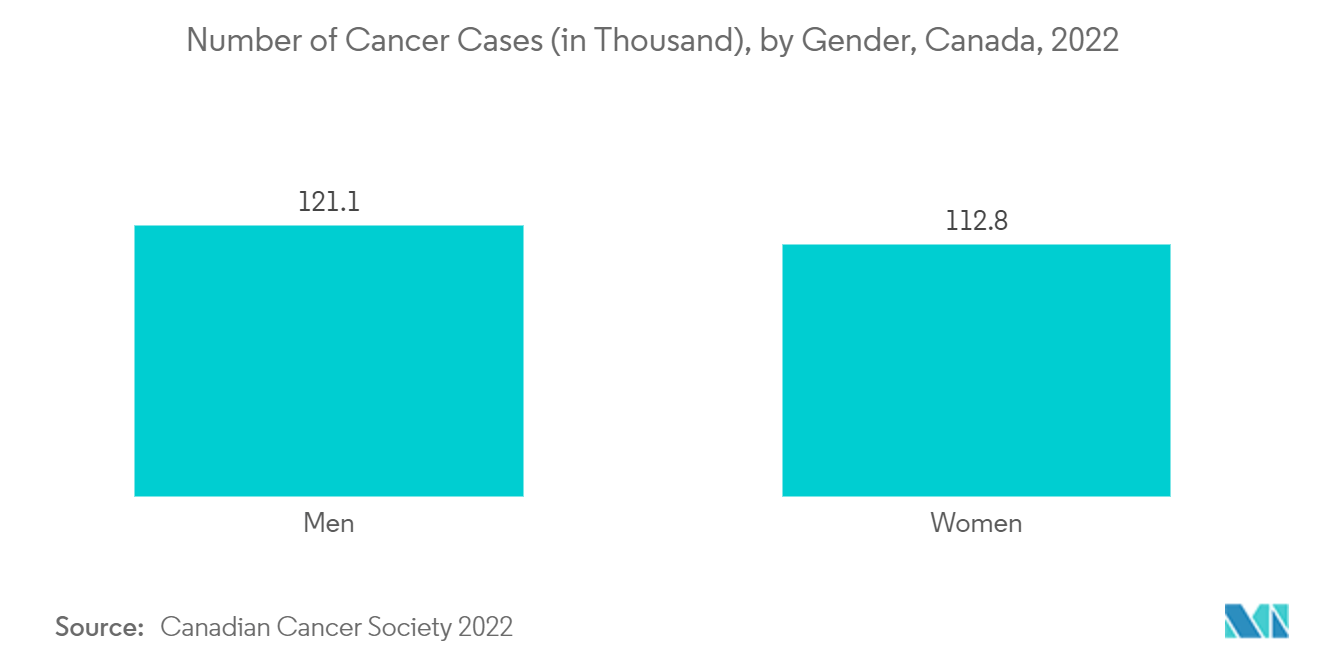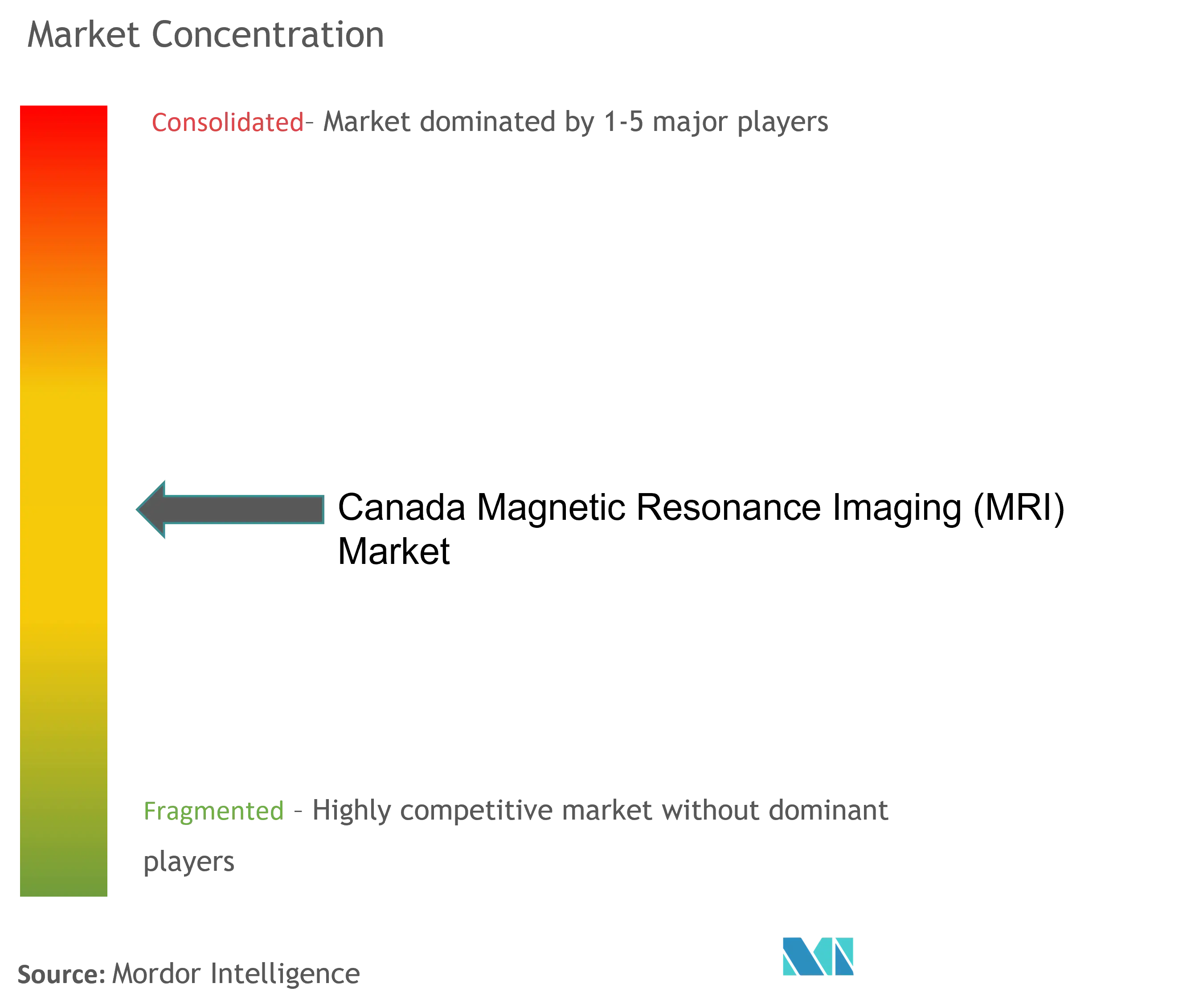Canada Magnetic Resonance Imaging Market Size

| Study Period | 2019 - 2029 |
| Base Year For Estimation | 2023 |
| Forecast Data Period | 2024 - 2029 |
| Historical Data Period | 2019 - 2022 |
| CAGR | 6.37 % |
| Market Concentration | Medium |
Major Players
*Disclaimer: Major Players sorted in no particular order |
Canada Magnetic Resonance Imaging Market Analysis
The Canada Magnetic Resonance Imaging (MRI) Market size is expected to grow from USD 227.11 million in 2023 to USD 309.26 million by 2028, registering a CAGR of 6.37% during the forecast period.
The COVID-19 pandemic profoundly affected Canada's magnetic resonance imaging (MRI) market due to the disruption to healthcare services and the involvement of diagnostic imaging examinations, tests, and procedures. For instance, according to a report from the Canadian Association of Radiologists in 2021, the COVID-19 pandemic affected wait times for medical imaging procedures nationwide. The patients waited for an average of 50 to 82 days for CT scans and 89 days for MRI imaging. This counted 20 to 52 days longer than the recommended 30-day wait time. Due to COVID-19, waitlists were longer, putting Canada in crisis mode for medical imaging. However, as the pandemic restrictions are eased, the market is expected to witness significant growth in the coming years due to the rise in the utilization of MRI equipment in hospitals and the emergence of advanced technologies in MRI equipment.
With the growing geriatric population and increasing prevalence of chronic diseases such as cancer, cardiovascular diseases, etc., the studied magnetic resonance imaging (MRI) market is expected to grow in Canada during the forecast period. For instance, according to the Canadian Cancer Society 2022 report, 233,900 new cancer cases were diagnosed in Canada in 2022. The high burden of cancer is expected to augment the demand for MRI services for imaging, thereby boosting market growth over the forecast period.
Furthermore, investments by the government to support the implementation of MRI scanners in a healthcare setting are expected to contribute to market growth. For instance, in December 2022, approximately USD 20 million was invested by the Ontario government as operating funding to support the installation of 27 new magnetic resonance imaging (MRI) machines in hospitals across Ontario. Moreover, in January 2023, the Ontario government planned to expand the availability of the services performed in community surgical and diagnostic centers, with a significant focus on cataract surgeries, MRI and CT imaging, and colonoscopy and endoscopy procedures. Thus, government initiatives focusing on the implementation and utilization of MRI services in Canada are expected to drive market growth over the forecast period.
Thus, owing to the increase in chronic disease that utilizes MRI imaging for disease detection and the rise in strategic activities by the key players, the studied market is expected to witness significant growth over the forecast period. However, the high cost of the MRI system is expected to restrain the market growth over the forecast period.
Canada Magnetic Resonance Imaging Market Trends
Low-Field Segment is Anticipated to Grow Over the Forecast Period
Low-field systems, defined as field strengths of 0.25-1T, might benefit from advancements in higher-field MRI, such as signal-to-noise ratio (SNR) reliance on the static magnetic field and its impact on achievable contrast, resolution, and acquisition times. The low-field MRI system may also be safer for patients with pacemakers or defibrillators, quieter, and easier to maintain and install. The low-field system segment is expected to witness significant market growth owing to the increase in benefits offered by low-field systems compared to other types and the presence of key players and their strategic product launches across Canada. Further, an increase in chronic diseases like heart disease is expected to fuel the demand for low-field systems MRI, thereby contributing to segment growth. For instance, according to the June 2022 update by CIHI, about 2.4 million Canadians had heart disease.
Low-field MRI machines are much more cost-effective than other MRI machines, significantly creating a demand for low-field MRI machines and contributing to segment growth over the forecast period. For instance, in an article published in September 2022 in Frontiers Journal, a portable, low-field MRI system is a cost-efficient option compared to high-field MRI, and low-field MRI costs 5% to 50% of a high-field MRI system.
Furthermore, the presence of key players and their strategic activities in Canada will likely drive segment growth over the forecast period. For instance, in February 2021, ReGen Scientific, a company that offers personalized, preventative, and regenerative health, became the first comprehensive health clinic in Canada to bring Synaptive Medical's Evry, a superconducting 0.5T head magnetic resonance imaging (MRI) system intended to provide MRI directly at the point-of-care, to their downtown Toronto location. Hence, increasing the installation of low-field MRI scanners in clinics nationwide is propelling the segment's growth. Similarly, in December 2021, Hyperfine Inc., creator of the first FDA-cleared portable magnetic resonance imaging (MRI) device, received the Health Canada licensing of Swoop and the commercial launch of the imaging system in Canada. The license of Swoop includes the recently FDA-cleared advanced reconstruction software using deep learning. With this license, the Swoop system is now available in Canada. Thus, introducing new systems in the country is expected to increase market growth.
Thus, owing to the high prevalence of cardiac diseases and the increased adoption of low-field MRI equipment, the studied segment is expected to grow significantly over the forecast period.

Musculoskeletal Segment is Expected to Witness a Significant Growth Over the Forecast Period
Magnetic resonance imaging (MR) utilizes a strong magnetic field and radio waves to create precise images of bones, soft tissues, and joints. The majority of the time, it is the greatest option for checking the body for degenerative diseases, tumors, and injuries. The musculoskeletal segment is expected to witness significant growth owing to the high prevalence of musculoskeletal diseases such as osteoarthritis, rheumatoid arthritis, psoriatic arthritis, gout, spondyloarthritis, etc., a rise in the geriatric population, an increase in accidents and injuries, rapid technological developments, and advantages offered by MRI equipment in diagnosing different types of musculoskeletal diseases.
The high prevalence of musculoskeletal diseases is expected to drive market growth since the MRI offers proper identification and depicts the progression of the disease. For instance, according to the Arthritis Canada 2021 report, the prevalence of arthritis is expected to rise to 9 million by 2040. Due to the increase in cases of arthritis in Canada, the demand for MRI equipment is expected to increase in the country, which may drive the growth of the studied segment in the market.
Additionally, the presence of some of the key market leaders in the country's new product launches and the increase in installation funding for MRI are also expected to positively impact the musculoskeletal segment in the country over the years. For instance, in December 2022, Owen Sound and Collingwood received MRI operating funding. Also, Owen Sound installed its second MRI machine functioning by the fall of 2023. Kincardine's first MRI is expected to be incorporated into a hospital expansion, which will be completed by 2025. Additionally, an increase in healthcare expenditures is one of the key elements driving the segment's growth because it involves diagnostic services for individuals with musculoskeletal disorders, further propelling market expansion.
Thus, owing to the high prevalence of musculoskeletal diseases and the rise in the adoption of MRI in musculoskeletal disease detection coupled with various strategic activities by the key players, the studied segment is expected to witness significant growth over the forecast period.

Canada Magnetic Resonance Imaging Industry Overview
The Canadian magnetic resonance imaging market is highly competitive and has several major players. A few of the major players currently dominate the market in terms of market share. Companies like Siemens Healthineers, GE Healthcare, Canon (Canon Medical Systems), and Koninklijke Philips N.V. hold a significant market share in magnetic resonance imaging.
Canada Magnetic Resonance Imaging Market Leaders
-
GE Healthcare
-
FUJIFILM Holdings Corporation
-
Koninklijke Philips N.V.
-
Canon (Canon Medical Systems)
-
Siemens Healthineers
*Disclaimer: Major Players sorted in no particular order

Canada Magnetic Resonance Imaging Market News
- April 2023: Kelowna General Hospital(KGH) in British Columbia installed a new MRI machine with an investment of CAD 30 million (USD 22.6 million) by the Ministry of Health. With the help of the installed MRI machine, the capacity for MRI scans KGH is likely to increase from approximately 7,000 to 15,000 per year.
- February 2023: Georgian Bay General Hospital (GBGH) in Canada received CAD 800,000 (USD 604,663) from the Ontario Ministry of Health as an annual operating fund to commence Magnetic Resonance Imaging (MRI) services in the hospital. Also, the funding covers the cost of staff and utilities.
Canada Magnetic Resonance Imaging Market Report - Table of Contents
1. INTRODUCTION
- 1.1 Study Assumptions and Market Definition
- 1.2 Scope of the Study
2. RESEARCH METHODOLOGY
3. EXECUTIVE SUMMARY
4. MARKET DYNAMICS
- 4.1 Market Overview
-
4.2 Market Drivers
- 4.2.1 Growing Burden of Chronic Diseases
- 4.2.2 Technological Advancement of MRI Systems
-
4.3 Market Restraints
- 4.3.1 High Cost of MRI Systems
-
4.4 Porter's Five Forces Analysis
- 4.4.1 Bargaining Power of Buyers/Consumers
- 4.4.2 Bargaining Power of Suppliers
- 4.4.3 Threat of New Entrants
- 4.4.4 Threat of Substitute Products
- 4.4.5 Intensity of Competitive Rivalry
5. MARKET SEGMENTATION
-
5.1 By Architecture
- 5.1.1 Closed MRI Systems
- 5.1.2 Open MRI Systems
-
5.2 By Field Strength
- 5.2.1 Low Field MRI Systems
- 5.2.2 High Field MRI Systems
- 5.2.3 Very High Field MRI Systems and Ultra-high MRI Systems
-
5.3 By Application
- 5.3.1 Oncology
- 5.3.2 Neurology
- 5.3.3 Cardiology
- 5.3.4 Gastroenterology
- 5.3.5 Musculoskeletal
- 5.3.6 Other Applications
6. COMPETITIVE LANDSCAPE
-
6.1 Company Profiles
- 6.1.1 Canon (Canon Medical Systems)
- 6.1.2 Fujifilm Holdings Corporation
- 6.1.3 GE Healthcare
- 6.1.4 Koninklijke Philips NV
- 6.1.5 Siemens Healthineers
- 6.1.6 Esaote SpA
- 6.1.7 Hyperfine, Inc.
- *List Not Exhaustive
7. MARKET OPPORTUNITIES AND FUTURE TRENDS
** Subject To AvailablityCanada Magnetic Resonance Imaging Industry Segmentation
As per the scope of the report, magnetic resonance imaging is a medical imaging technique used in radiology to produce pictures of the anatomy and the body's physiological processes. These pictures are further used to diagnose and detect the presence of abnormalities in the body. The Canada Magnetic Resonance Imaging (MRI) Market is Segmented by Architecture (Closed MRI Systems and Open MRI Systems), Field Strength (Low Field MRI Systems, High Field MRI Systems, Very High Field MRI Systems, and Ultra-high MRI Systems), Application (Oncology, Neurology, Cardiology, Gastroenterology, Musculoskeletal, and Other Applications). The report offers the value (in USD) for the above segments.
| By Architecture | Closed MRI Systems |
| Open MRI Systems | |
| By Field Strength | Low Field MRI Systems |
| High Field MRI Systems | |
| Very High Field MRI Systems and Ultra-high MRI Systems | |
| By Application | Oncology |
| Neurology | |
| Cardiology | |
| Gastroenterology | |
| Musculoskeletal | |
| Other Applications |
Canada Magnetic Resonance Imaging Market Research FAQs
What is the current Canada Magnetic Resonance Imaging (MRI) Market size?
The Canada Magnetic Resonance Imaging (MRI) Market is projected to register a CAGR of 6.37% during the forecast period (2024-2029)
Who are the key players in Canada Magnetic Resonance Imaging (MRI) Market?
GE Healthcare, FUJIFILM Holdings Corporation, Koninklijke Philips N.V., Canon (Canon Medical Systems) and Siemens Healthineers are the major companies operating in the Canada Magnetic Resonance Imaging (MRI) Market.
What years does this Canada Magnetic Resonance Imaging (MRI) Market cover?
The report covers the Canada Magnetic Resonance Imaging (MRI) Market historical market size for years: 2019, 2020, 2021, 2022 and 2023. The report also forecasts the Canada Magnetic Resonance Imaging (MRI) Market size for years: 2024, 2025, 2026, 2027, 2028 and 2029.
Canada Magnetic Resonance Imaging Industry Report
Statistics for the 2024 Canada Magnetic Resonance Imaging market share, size and revenue growth rate, created by Mordor Intelligence™ Industry Reports. Canada Magnetic Resonance Imaging analysis includes a market forecast outlook 2029 and historical overview. Get a sample of this industry analysis as a free report PDF download.



